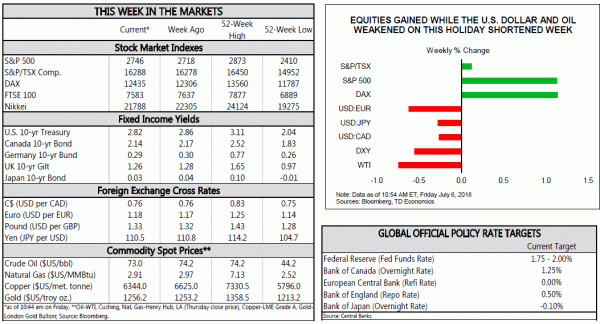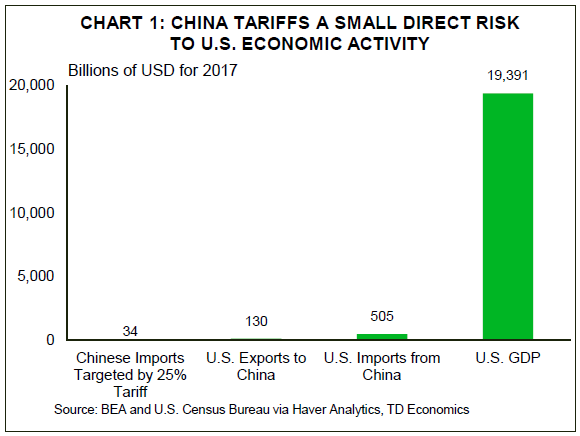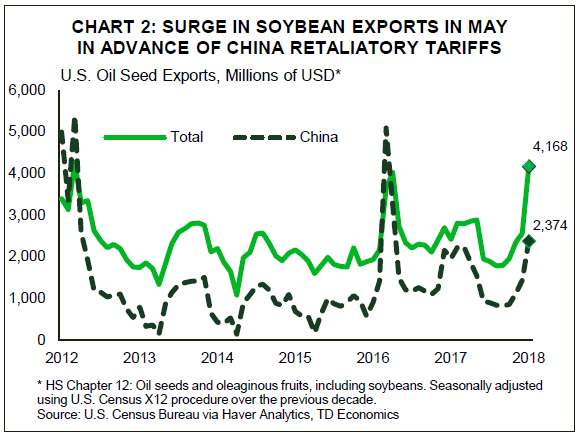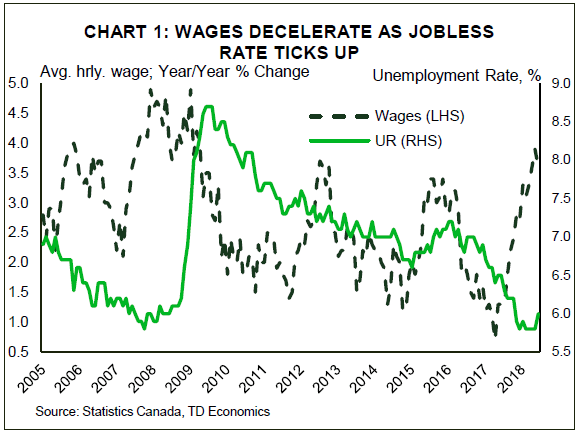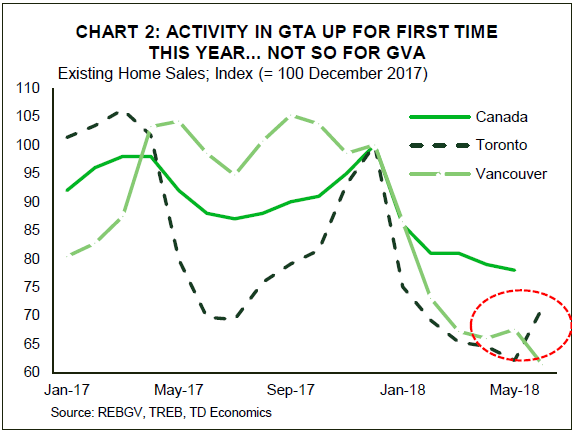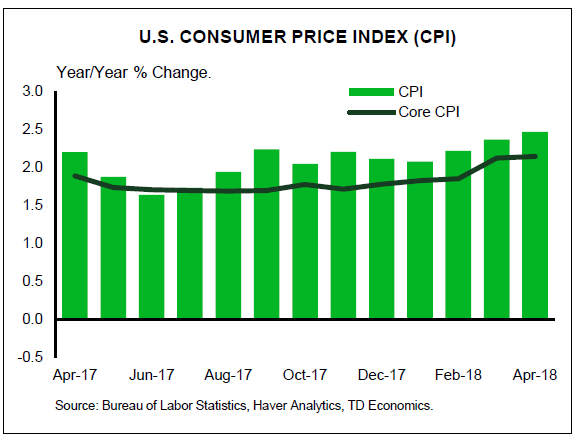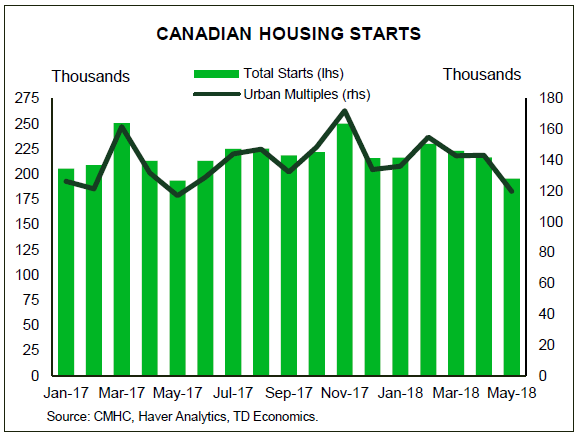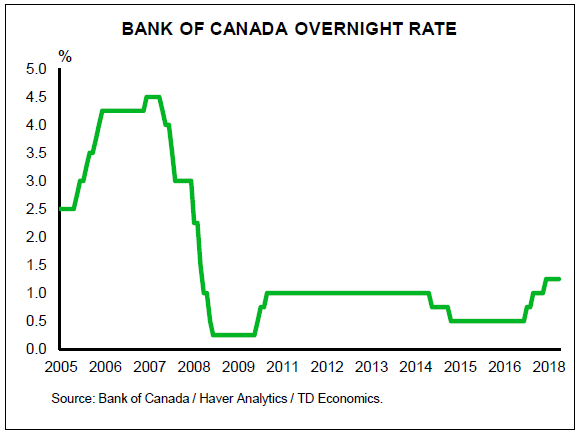U.S. Highlights
- A holiday-shortened week was nevertheless chock-full of data releases that confirmed the U.S. economy continues to expand at a strong above-trend pace.
- Economic activity remains robust, but there are signs that trade uncertainty may be impeding further improvement.
- Tariffs on $34 billion in goods from China, and on U.S. goods to China, take effect today. Although these tariffs remain a downside risk to our economic outlook, further escalation could prove direr.
Canadian Highlights
- The holiday-shortened week was a very busy one for investors in Canada, with global political developments and economic data to digest ahead of the Bank of Canada monetary policy decision next week.
- Sentiment was soured by softer oil prices, related to higher Saudi production, as well as rising trade tensions between Canada’s two most important trade partners, as the U.S. implemented additional tariffs on Chinese exports.
- Job growth was solid, but wages decelerated and unemployment rose on labour market influx. The trade deficit widened, but largely due to transitory factors, while housing data indicated diverging dynamics: GTA seeing a rebound while GVA continued to correct. Overall, the data was good enough for a hike, but risks remain.
U.S. – China Tariffs Likely to Impede Economic Momentum
Although a holiday shortened week, it was nevertheless chock-full of data releases. Once again, this week’s data flow confirms that the U.S. economy is continuing to experience a strong, above-trend expansion. That said, tariffs against China imports that take effect today, and reciprocal retaliatory tariffs by China on U.S. goods, could act to impede economic momentum.
Kicking off the week was a surprisingly strong headline print in the Institute of Supply Management (ISM) manufacturing survey for June. However, the details of the report revealed that not all is well in the manufacturing sector. The positive surprise was due to a surge in supplier deliveries, as trade-related uncertainty resulted in lead-time extensions for production materials, transportation delays, and component shortages. The ISM services survey also surprised to the upside on the back of a rebound in business activity and new orders. However, respondents expressed a fair degree of anxiety about trade-related uncertainty that is creating price volatility. Still, both surveys overwhelmingly relayed the theme of a strong U.S. economy heading into the second half of the year, but one in which unresolved challenges – namely labor shortages and new tariffs – could act to impede further improvement.
June new car sales continued the theme of strong U.S. demand. At 17.4 million units, car sales were above expectations of 17 million units, but still well below the 18 million unit pace from last June. The current pace of sales is largely in line with fundamentals, and tightening credit standards should continue to contain any further upside.
Lastly, this morning’s payrolls data rounded out the positive data for the week. Non-farm payrolls rose by 213k in June, above market expectations for 195k. A strong increase in the labor force and an uptick in job seekers combined to push up the unemployment rate to 4.0%. Although usually associated with a weak economy, in this case a rising unemployment rate is a sign that strong job growth and rising wages is encouraging more people to enter the labor market, acting to further absorb what little labor market slack remains.
With the U.S. economy on such a solid economic footing it should be able to withstand some drag from escalating protectionist trade actions. Effective today, the U.S. has imposed a 25% tariff on $34 billion of annual Chinese imports of industrial machinery, aerospace, and transportation goods. China has retaliated in kind, largely against U.S. agricultural products, vehicles, and aquatic products. Another $16 billion in goods are expected to be targeted by tariffs by both sides in the coming weeks.
All told, the tariffs and counter-tariffs imposed by the U.S. and their trading partners, respectively, remain a downside risk to our U.S. and global economic growth outlook (Chart 1). Trade data are already showing signs that tariffs are affecting activity (Chart 2). An escalation in tensions, such as a 25% tariff on automotive imports, could ultimately cost the U.S. economy more than $100 billion in lost output, stoke inflation, and put about 250k jobs at risk. We remain hopeful that such a scenario never materializes, and that ongoing discussions between the U.S. and its major trading partners prove fruitful.
Canada – Good Enough For a Hike
The holiday-shortened week was a very busy one for investors in Canada, with global political developments and economic data to digest. Equities faded late in the week on oil prices, pushed lower on higher Saudi production and trade tensions, but a broad-based recovery took hold, with a positive end to the week looking like at the time of writing. The U.S. implemented additional $34bn in tariffs on Chinese exports taking relations to a new low and weighing on the greenback – down 0.5% on Friday vis-à-vis most majors.
Escalating tensions between Canada’s two most important trade partners weighted on sentiment, but economic data has so far remained intact. Hiring resumed in June with the Canadian economy adding 32k jobs last month. Gains were led by construction and manufacturing, while services disappointed, losing jobs on net for the first time in five months. Despite the job creation, unemployment ticked higher by 20bps to 6.0% as more than 75k people entered the labour force – a six year high. Average wages decelerated, down some 30bps, but at 3.6% y/y remains near a decade-high (Chart 1).
Canadian trade figures were less inspiring with the deficit in May widening to $2.8bn. Imports were up 1.7% and 1.2% in nominal and real terms, respectively. They were somewhat boosted by airliner and gasoline imports, but strength was broad-based across categories, indicative of healthy domestic demand. Exports, on the other hand were weak, remaining flat in nominal terms while volumes fell 1.0%. While much of the weakness was related to transitory factors including supply disruptions in automotive parts and work stoppages in iron mines, exports are unlikely to surge going forward. Alongside ongoing NAFTA uncertainty, the imposition of tariffs in June will have a severe impact on the Canadian metals industry, with potential for downstream effects a real risk.
Another risk central to the Canadian economy is the housing market. This week we got June real estate board data for the two most closely watched markets in Canada. Figures from TREB suggested the recovery in the GTA market has begun in earnest. Sales rose for the first time this year (Chart 2), surging by nearly 18% in June according to TREB figures, but remaining well below historical norms. New listings, meanwhile, pulled back, helping rebalance the market. The tighter conditions led prices higher, with the HPI up about 0.2% while average prices rose over 3% – on account of increased activity in the most expensive single-detached segment. The GVA by contrast, saw both activity and new listings pull back around 10% apiece in June, according to REBGV figures. The decline in sales was the fifth in six months, with the softness manifesting in prices. The HPI was down 0.5% in June, the third consecutive decline and the weakest performance since late-2016, which also followed a provincial policy change.
Risks related to trade and housing will surely be top of mind for the Governing Council when it meets next week to discuss monetary policy. But, until they are seen as likely to materialize they will not drive monetary policy. This is set on incoming data and the outlook, which are relatively sanguine. From that standpoint, another 25 basis point hike next week is the most appropriate move.
U.S.: Upcoming Key Economic Releases
U.S. Consumer Price Index – June
Release Date: July 12, 2018
Previous: 0.2% m/m; core 0.2% m/m
TD Forecast: 0.3% m/m; core 0.2% m/m
Consensus: 0.2% m/m; core 0.2% m/m
We expect CPI to hit 2.9% y/y in June, with prices up 0.3% m/m, while core inflation should rise to 2.3% on a 0.2% m/m increase. Steel and aluminum tariffs are unlikely to create a meaningful lift to goods categories but risks are generally tilted to the upside on the back of firmer imported consumer goods prices. Meanwhile, a rebound in shelter costs should underpin core services.
Canada: Upcoming Key Economic Releases
Canadian Housing Starts – June
Release Date: July 10, 2018
Previous: 195k
TD Forecast: 210k
Consensus: N/A
TD looks for housing starts to rebound to a 210k pace in June on a recovery in apartments and other multi-unit projects. Multifamily dwelling starts printed at a 12m low in May which flies against continued strength in building permits (through April) and strong demand in the resale market. On the other hand, we expect single family starts to decline in June following a steady grind lower in permit issuance.
Bank of Canada Rate Decision
Release Date: July 11, 2018
Previous: 1.25%
TD Forecast: 1.50%
Consensus: 1.50%
We expect the Bank of Canada to lift the overnight rate by 25 bps next week, which is broadly in line with consensus. The Bank’s description of recent economic activity should be constructive which may give the communique a hawkish tinge, but we emphasize that the BoC will remain intensely data dependent going forward. As such, next week’s communique will not constrain the Governor in September or October. Both growth and inflation have evolved roughly in line with the BoC’s forecast from April, so we don’t anticipate any significant changes in their economic outlook. Governor Poloz has stated that they will only incorporate announced trade measures into their projection and not the threatened auto tariffs, so the impact from trade uncertainty should be fairly small relative to prior assumptions. Still, the tightening path will remain very gradual, and if the economy decelerates into 2018H2 they could easily stay on the sidelines for the rest of the year.




